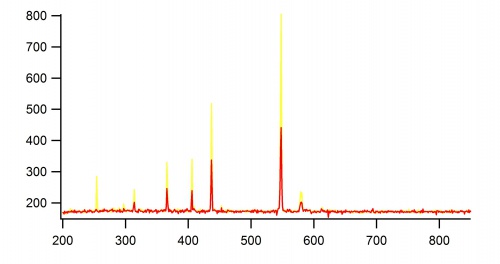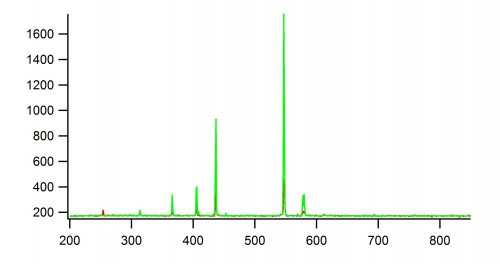Difference between revisions of "Emission intensity of mercury lamp"
Mohannadfa (talk | contribs) |
Mohannadfa (talk | contribs) |
||
| Line 1: | Line 1: | ||
The emission intensity of mercury lamp was investigated using a photo diode detector. The effect of covering the lamp with glass was also experimented since glass is well known for its ability to block UV light. To start off, the mercury lamp was heated for 5 minutes with a glass test tube covering it. The intensity of the emitted light was measured. Then the glass test tube was removed and the intensity was measured again. Figures 1 shows the variation in the intensity when the glass test tube is on and off. The yellow trace always has greater intensities. e.g. at wavelengths 430 nm and 550 nm, where the later belongs to the green region of the visible spectrum, compared to the red trace. Moreover, there is a yellow peak at around 250 which falls in the UV region of the spectrum. This makes sense because the glass test tube was not placed on the lamp and so UV light was not blocked. Figure two represents the two conditions as in figure 1, but in this case, a pair of eyeglasses were added to measure the difference in intensities. The same trend was shown as in figure 1 but the intensities were decreased because the lenses of the eye glasses added a layer of barrier that decreased the intensity of light detected. A small red peak is shown at 250 nm when the test tube was off the lamp, representing the detection of UV light. | The emission intensity of mercury lamp was investigated using a photo diode detector. The effect of covering the lamp with glass was also experimented since glass is well known for its ability to block UV light. To start off, the mercury lamp was heated for 5 minutes with a glass test tube covering it. The intensity of the emitted light was measured. Then the glass test tube was removed and the intensity was measured again. Figures 1 shows the variation in the intensity when the glass test tube is on and off. The yellow trace always has greater intensities. e.g. at wavelengths 430 nm and 550 nm, where the later belongs to the green region of the visible spectrum, compared to the red trace. Moreover, there is a yellow peak at around 250 which falls in the UV region of the spectrum. This makes sense because the glass test tube was not placed on the lamp and so UV light was not blocked. Figure two represents the two conditions as in figure 1, but in this case, a pair of eyeglasses were added to measure the difference in intensities. The same trend was shown as in figure 1 but the intensities were decreased because the lenses of the eye glasses added a layer of barrier that decreased the intensity of light detected. A small red peak is shown at 250 nm when the test tube was off the lamp, representing the detection of UV light. | ||
| + | |||
| + | [[File:No cap.jpg|500px|thumb|left|Figure.1]] | ||
[[File:Cap_on.jpg|500px|thumb|left|Figure.2]] | [[File:Cap_on.jpg|500px|thumb|left|Figure.2]] | ||
| − | |||
| − | |||
Revision as of 23:45, 26 January 2017
The emission intensity of mercury lamp was investigated using a photo diode detector. The effect of covering the lamp with glass was also experimented since glass is well known for its ability to block UV light. To start off, the mercury lamp was heated for 5 minutes with a glass test tube covering it. The intensity of the emitted light was measured. Then the glass test tube was removed and the intensity was measured again. Figures 1 shows the variation in the intensity when the glass test tube is on and off. The yellow trace always has greater intensities. e.g. at wavelengths 430 nm and 550 nm, where the later belongs to the green region of the visible spectrum, compared to the red trace. Moreover, there is a yellow peak at around 250 which falls in the UV region of the spectrum. This makes sense because the glass test tube was not placed on the lamp and so UV light was not blocked. Figure two represents the two conditions as in figure 1, but in this case, a pair of eyeglasses were added to measure the difference in intensities. The same trend was shown as in figure 1 but the intensities were decreased because the lenses of the eye glasses added a layer of barrier that decreased the intensity of light detected. A small red peak is shown at 250 nm when the test tube was off the lamp, representing the detection of UV light.

